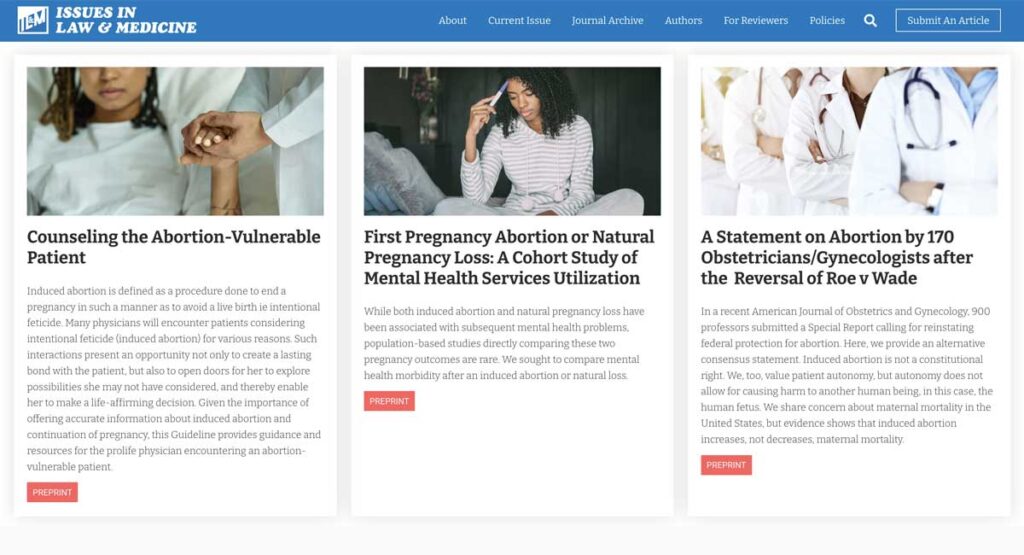The peer-reviewed journal Issues in Law & Medicine has published three pre-print articles online ahead of the release of its Fall 2024 volume. Go to the journal’s website to view the following three articles:
Counseling the Abortion-Vulnerable Patient — Induced abortion is defined as a procedure done to end a pregnancy in such a manner as to avoid a live birth ie intentional feticide. Many physicians will encounter patients considering intentional feticide (induced abortion) for various reasons. Such interactions present an opportunity not only to create a lasting bond with the patient, but also to open doors for her to explore possibilities she may not have considered, and thereby enable her to make a life-affirming decision. Given the importance of offering accurate information about induced abortion and continuation of pregnancy, this Guideline provides guidance and resources for the prolife physician encountering an abortion-vulnerable patient.
First Pregnancy Abortion or Natural Pregnancy Loss: A Cohort Study of Mental Health Services Utilization — While both induced abortion and natural pregnancy loss have been associated with subsequent mental health problems, population-based studies directly comparing these two pregnancy outcomes are rare. The authors sought to compare mental health morbidity after an induced abortion or natural loss. Continuously eligible Medicaid beneficiaries age 16 in 1999 were assigned to two cohorts based upon the first pregnancy outcome: abortion (n = 1,331) or natural loss (n = 605). Outcomes were mental health outpatient visits, inpatient hospital admissions and hospital days of stay per patient per year. Average exposure periods before and after the first pregnancy outcome for each cohort were used to adjust the mental health service rates. Prior to the first pregnancy outcome, all three utilization rates were significantly higher for the natural loss cohort compared to the abortion cohort. For the abortion cohort, the per-patient per-year increase from the pre- to post-pregnancy periods was significant for all three rates: 2.04 times for outpatient visits (p < 0.0001), 3.04 times for inpatient admissions (p = 0.0003), and 3.01 times for hospital days of stay (p = 0.0112). None of the pre-to-post rate increases were significant for the natural loss cohort. Higher pre-pregnancy use rates for women who experience a natural pregnancy loss indicate that increased mental health services use following abortion cannot be solely attributed to pre-existing mental illness. Only the abortion cohort, but not the natural loss cohort, experienced significant increases in mental health services use following the first pregnancy outcome.
A Statement By 170 Obstetrician-Gynecologists After the Reversal of Roe v. Wade — In a recent American Journal of Obstetrics and Gynecology, 900 professors submitted a Special Report calling for reinstating federal protection for abortion. Here, the authors provide an alternative consensus statement. Induced abortion is not a constitutional right. We, too, value patient autonomy, but autonomy does not allow for causing harm to another human being, in this case, the human fetus. We share concern about maternal mortality in the United States, but evidence shows that induced abortion increases, not decreases, maternal mortality. We share the authors’ concern for the effect of induced abortion on minority populations and mourn the fact that the abortion rate in non-Hispanic black patients is three times that of non-Hispanic white patients and twice that of Hispanic patients. Many obstetricians/gynecologists, like ourselves, do not support abortion, and most obstetricians/gynecologists do not perform abortions. Induced abortion is not necessary to provide evidence-based care. We also have seen tragic situations and misinformation and want to work toward addressing these issues. We support the highest level of clinical practice, bodily autonomy, reproductive freedom, and evidence-based care for both our patients—the pregnant woman and the human being in utero—whom we have dedicated our lives to serving.






